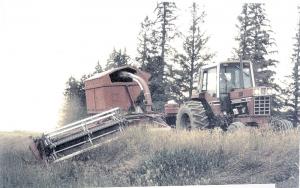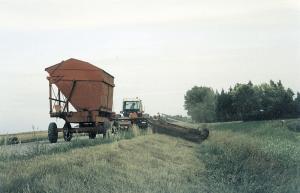Ditch Swather Makes Gathering "Free" Hay Easy
With 140 cows in dry lot year round, Harold Reimer needs lots of forage. Since he built his first-of-its-kind ditch swather, he's been getting all he needs for free. Center pivots operating in fields near his farm often overshoot field edges and irrigate the ditch grass. Even in a dry year, the grass grows 3 to 4 ft. tall.
"Gravel roadsides are usually too steep to harvest," explains Reimer. "I needed a machine that could stay on the road, cut the grass and pull it up to the chopper."
With the help of a friend and professional welder, Harvey Nikkel, Reimer put together a rigid frame with a swather header mounted on a hydraulic arm. The header can be lowered down the ditch bank to cut and transfer grasses up to a forage harvester on the road that chops and blows into a high dump wagon. A 110 hp tractor powers all three units. Reimer uses a truck to transfer chopped grasses back to his bunkers.
The concept for the ditch swather came from a Saskatchewan header manufacturer who had built a couple of machines for that purpose. The manufacturer was more than willing to share suggestions and also sent him a video of a unit operating.
"He was very helpful," says Reimer. "Seeing it operating helped me develop a pattern. A farmer who owns one gave me some suggestions, too."
Reimer started by building an all-steel framework. It had to be capable of staying on the roadway while the header went from a vertical position to 45_ below road level on the steep ditch slope.
"I used 7 by 7-in. square steel tubing for the hitch, sealed it at both ends and used it as the hydraulic fluids reservoir," explains Reimer. "The wheel legs and the main carriage are built out of 4 by 5-in. steel tubing, and the header arm is built out of heavier walled 5 by 5-in. tubing."
Reimer tore apart an older sugar beet harvester for parts. He used the hinge from the
walking axle as one of the hinges for the header arm.
A brace from the rear of the header is hinged to a point on the frame behind the
main pivot point. It serves to counter the high degree of torque on the end of the header and
helps stabilize the header as it’s lifted and lowered.
To make the header, Reimer cut a used, 25-ft. Case IH header in half and mounted it on
the new frame. The aluminum reel was simple to cut and reassemble. The removable platform tables were lengthened or shortened as needed with new canvas. All the drives were hydraulic, which made it easy to synchronize the speeds of the canvas-covered platforms once they were reassembled.
“I learned a lot about hydraulics from a guy at Kirchner Mfg. where I bought parts. He
went out of his way to help on controls and how to hook them up.”
The shortened header feeds the ditch grass to the left side of the frame. Here, it’s picked up by a short platform and lifted up to drop on a 16-ft. conveyer. This long conveyer moves the grass back to the forage harvester.
“I had to add the second short platform to the header conveyer to guide the grass onto
the rear conveyer,” explains Reimer. “Without it, as the header lowered onto steep banks,
grass would be thrown up and over the rear conveyer.”
Reimer knew that lowering and lifting the header arm would require a significant counterweight on the opposite side of the frame. In addition to the heavy steel frame and the
oil-filled reservoir in the hitch, he mounted a 750-lb., 25-in. dia. circle cut from a 5-in. thick
sheet of steel. When that was not enough, he added two 350-lb. tractor wheel weights.
Finally, he cut a hole in a length of the frame on that side and filled it with car wheel balancing lead weights. A pail set inside the circle formed by the wheel weights was also
filled with lead weights.
“The header arm weighs about 2,500 lbs. with the entire machine running about 6,000
lbs.,” says Reimer.
To power the forage harvester, Reimer ran a 15-ft. pto shaft across the ditch swather frame. Along the way, a belt pulley mounted on the shaft powers a hydraulic pump on the swather. It supplies pressure to all the hydraulics except the cylinder for the header
arm. That is run directly off the tractor’s hydraulic system. Running everything off
hydraulic orbital motors made set-up much easier than belts and pulleys.
“Since the orbit motors that are direct drive on the conveyer platforms are all the same size, they run at the same speed,” he says. “All I had to do was plumb them in series
and, that way if one stops, they all stop.” The entire machine less the used header
cost him about $10,000.
Contact: FARM SHOW Followup, Harold Reimer, Box 1542, Coaldale, Alberta, Canada T1M 1N3 (ph 403 345-3320; email: hbreimer@telusplanet.net).

Click here to download page story appeared in.
Click here to read entire issue
Ditch Swather Makes Gathering Free Hay Easy CROPS Miscellaneous With 140 cows in dry lot year round Harold Reimer needs lots of forage Since he built his first-of-its-kind ditch swather he s been getting all he needs for free Center pivots operating in fields near his farm often overshoot field edges and irrigate the ditch grass Even in a dry year the grass grows 3 to 4 ft tall Gravel roadsides are usually too steep to harvest explains Reimer I needed a machine that could stay on the road cut the grass and pull it up to the chopper With the help of a friend and professional welder Harvey Nikkel Reimer put together a rigid frame with a swather header mounted on a hydraulic arm The header can be lowered down the ditch bank to cut and transfer grasses up to a forage harvester on the road that chops and blows into a high dump wagon A 110 hp tractor powers all three units Reimer uses a truck to transfer chopped grasses back to his bunkers The concept for the ditch swather came from a Saskatchewan header manufacturer who had built a couple of machines for that purpose The manufacturer was more than willing to share suggestions and also sent him a video of a unit operating He was very helpful says Reimer Seeing it operating helped me develop a pattern A farmer who owns one gave me some suggestions too Reimer started by building an all-steel framework It had to be capable of staying on the roadway while the header went from a vertical position to 45_ below road level on the steep ditch slope I used 7 by 7-in square steel tubing for the hitch sealed it at both ends and used it as the hydraulic fluids reservoir explains Reimer The wheel legs and the main carriage are built out of 4 by 5-in steel tubing and the header arm is built out of heavier walled 5 by 5-in tubing Reimer tore apart an older sugar beet harvester for parts He used the hinge from the walking axle as one of the hinges for the header arm A brace from the rear of the header is hinged to a point on the frame behind the main pivot point It serves to counter the high degree of torque on the end of the header and helps stabilize the header as it’s lifted and lowered To make the header Reimer cut a used 25-ft Case IH header in half and mounted it on the new frame The aluminum reel was simple to cut and reassemble The removable platform tables were lengthened or shortened as needed with new canvas All the drives were hydraulic which made it easy to synchronize the speeds of the canvas-covered platforms once they were reassembled “I learned a lot about hydraulics from a guy at Kirchner Mfg where I bought parts He went out of his way to help on controls and how to hook them up ” The shortened header feeds the ditch grass to the left side of the frame Here it’s picked up by a short platform and lifted up to drop on a 16-ft conveyer This long conveyer moves the grass back to the forage harvester “I had to add the second short platform to the header conveyer to guide the grass onto the rear conveyer ” explains Reimer “Without it as the header lowered onto steep banks grass would be thrown up and over the rear conveyer ” Reimer knew that lowering and lifting the header arm would require a significant counterweight on the opposite side of the frame In addition to the heavy steel frame and the oil-filled reservoir in the hitch he mounted a 750-lb 25-in dia circle cut from a 5-in thick sheet of steel When that was not enough he added two 350-lb tractor wheel weights Finally he cut a hole in a length of the frame on that side and filled it with car wheel balancing lead weights A pail set inside the circle formed by the wheel weights was also filled with lead weights “The header arm weighs about 2 500 lbs with the entire machine running about 6 000 lbs ” says Reimer To power the forage harvester Reimer ran a 15-ft pto shaft across the ditch swather frame Along the way a belt pulley mounted on the shaft powers a hydraulic pump on the swather It supplies pressure to all the hydraulics except the cylinder for the header arm That is run directly off the tractor’s hydraulic system Running everything off hydraulic orbital motors made set-up much easier than belts and pulleys “Since the orbit motors that are direct drive on the conveyer platforms are all the same size they run at the same speed ” he says “All I had to do was plumb them in series and that way if one stops they all stop ” The entire machine less the used header cost him about $10 000 Contact: FARM SHOW Followup Harold Reimer Box 1542 Coaldale Alberta Canada T1M 1N3 ph 403 345-3320; email: hbreimer@telusplanet net
To read the rest of this story, download this issue below or click
here to register with your account number.








